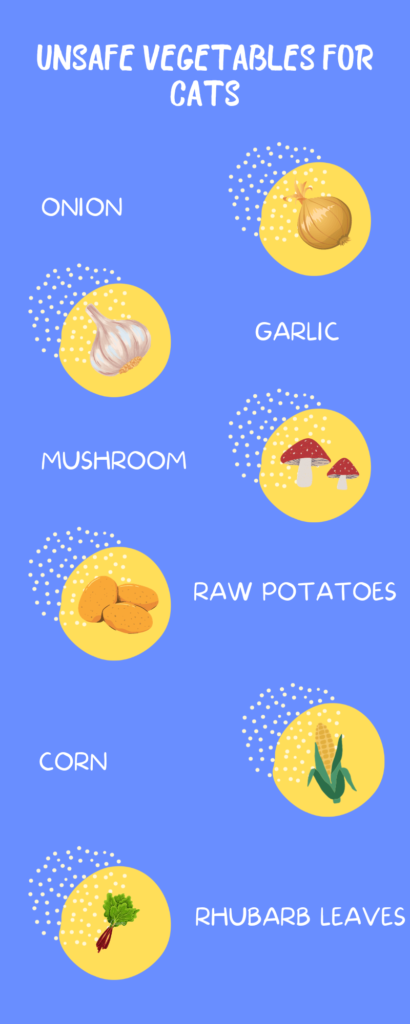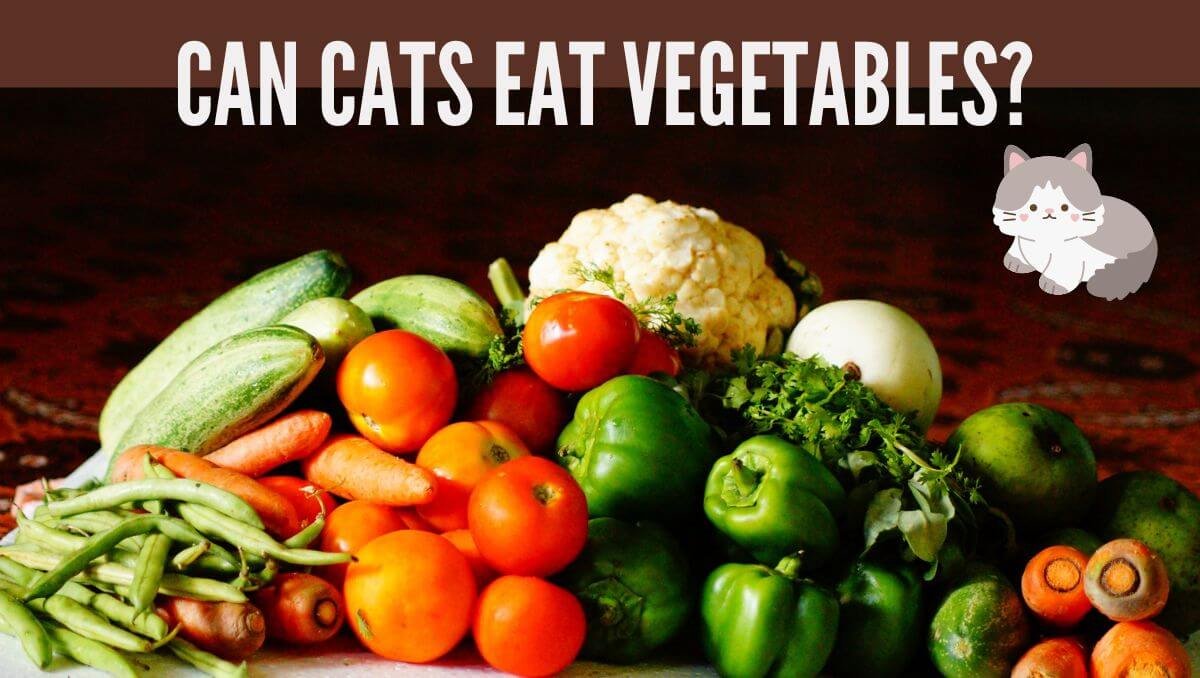Many cat owners wonder if they can share some of their healthy vegetable snacks with their feline friends. It’s common to want to offer wholesome human foods to the pets we love. However, cats have very different nutritional requirements than humans. This leaves cat owners with the question – can cats eat vegetables safely?
In this article, we’ll explore how vegetables fit into a cat’s naturally carnivorous diet. Keep reading to learn which veggies may provide benefits versus those to avoid, plus tips for carefully integrating some vegetables into your cat’s meals.
Can Cats Eat Vegetables?
Yes, cats can occasionally enjoy some vegetables but with caution. To understand if vegetables have a place in feline nutrition, it’s essential to first look at cats’ biological needs. Cats are carnivores, meaning they require key nutrients from meat, organs, and bones to thrive. Unlike humans, cats’ digestive systems are adapted specifically to process proteins and fats from animal prey.
Cats need high levels of nutrients like protein, vitamin A, arginine, and taurine found predominantly in ingredients like meat. Plant matter makes up only a tiny portion of what free-roaming cats consume. This means vegetables are not a big part of cats’ natural ancestral diets.
Vegetables in a Cat’s Diet
Given their carnivorous requirements, vegetables should never form a main part of your cat’s diet. However, some cooked veggies in moderation can provide supplementary vitamins, minerals, and antioxidants when added to cats’ regular high-protein meals.
Vegetables also add flavor and texture variety, which can tempt finicky eaters. Some cats enjoy small amounts of certain veggies as occasional treats. Just don’t replace meat nutrition or overdo veggie portions. Consult your vet when first introducing vegetables to ensure balance.
Safe Vegetables for Cats

When properly prepared and served in moderation, certain cooked vegetables can be safely offered to cats. Some veggies provide beneficial nutrients that complement feline diets. Here are some cat-safe vegetable options to discuss with your vet:
Carrots
Well-cooked, mashed carrots provide beta-carotene. Introduce slowly starting with just a teaspoon or two. Cook pieces thoroughly until soft enough to mash into an easily digestible texture.
Green Beans
These beans offer key vitamins and minerals like vitamin K, iron, and manganese. Lightly steam small cut pieces of green beans to retain nutrients while softening them. Start with just 2-3 bean pieces mixed into food.
Pumpkin
Plain canned pumpkin provides fiber to aid digestion. Make sure canned pumpkin contains no added sugars or spices. Start by mixing just a teaspoon or two into your cat’s regular meals to see if tolerated.
Peas
Peas deliver antioxidants, phytonutrients, and vitamin K. Select fresh or frozen peas and cook thoroughly. Then mash peas into a puree to make them digestible for cats before mixing a small spoonful into food. Introduce peas gradually.
Bell Peppers
Bell peppers provide vitamin A, vitamin C, and beta-carotene. Choose fresh peppers, seed them, and chop them into small pieces before lightly cooking. Introduce minced, cooked peppers gradually into your cat’s food in tiny amounts.
Cabbage
Cabbage offers antioxidants, vitamin C, and fiber. Shred a small amount of fresh cabbage and cook thoroughly until very soft. Then mix a tablespoon or less into your cat’s meals to provide supplemental nutrition from cabbage.
Turnip Greens
Turnip greens supply key nutrients like calcium, vitamin K, vitamin C, and copper. Blanch fresh turnip greens to soften them, then chop finely. Mix a spoonful into food and monitor for digestive issues before gradually increasing portions.
Vegetables to Avoid for Cat Health

While certain cooked vegetables can be safe for cats in moderation, there are also many vegetables cat owners should avoid feeding their felines entirely. Certain veggies contain compounds that can be toxic or harmful to cats when ingested. It’s important to know which vegetable species to keep away from curious cats.
Vegetables that should be avoided for cat health include:
Onions
Onions contain toxic substances called disulfides that damage red blood cells in cats, causing dangerous anemia. So no matter how much your cat begs, never feed them any onions!
Garlic
Like onions, garlic also has certain compounds that will cause hemolytic anemia in cats. So garlic should be kept away from cats at all times.
Mushrooms
Raw mushrooms can have toxins, and even cooked mushrooms can irritate a cat’s digestive system. It’s safer to avoid mushrooms altogether rather than risk exposing cats.
Raw Potatoes
Potatoes contain glycoalkaloids that are toxic for cats, especially raw. Only feed your cat thoroughly cooked potatoes, never raw or undercooked ones.
Rhubarb Leaves
Rhubarb leaves contain oxalic acid, which can cause severe kidney damage in cats. Do not let your cat nibble on rhubarb leaves.
Corn
The digestion of corn can be difficult for cats, potentially causing intestinal issues, vomiting, or obstruction. Only offer small portions of cooked corn occasionally if your cat tolerates it.
Exploring Other Food Options for Cats
Certain cooked lean meats like plain chicken, turkey, or beef offer excellent protein sources for cats. Specific fruits like blueberries, pumpkin, and cantaloupe provide vitamins and fiber when given sparingly. Some whole grains like oats or brown rice can be healthy additions in small amounts if cooked.
Plain, unsweetened yogurt contains probiotics that may aid digestion, but dairy should be limited due to lactose intolerance. Foods like cheese and ice cream are too high in fat for cats. Occasional treats of almonds or cooked eggs can supplement nutrition. Salmon and tuna provide healthy oils when served in moderation.
Alternatively, there are various foods including fruits, and other foods that can be safely given to cats.
Professional Guidance and Balanced Diet
While vegetables can add interest to your cat’s menu, always consult your veterinarian first. They can identify any potential veggie intolerances for your cat. For example, cats with kidney disease may tolerate only limited vegetables.
Senior cats also have different needs than lively kittens. An ill or finicky cat may need more enticement through flavor additions. Your vet understands your cat’s health conditions best and can recommend suitable vegetables and serving sizes.
When introduced carefully under veterinary supervision, vegetables can provide extra nutrition. But remember meat and animal-derived oils should still be your cat’s primary diet focus. Vegetables complement carnivorous diets but lack the complete proteins carnivores require.
Conclusion
Cat’s biological makeup means they require meat-focused nutrition. While we think of veggies as healthy, cats’ digestive systems aren’t designed to get full nourishment from plant foods. However, certain cooked vegetables may provide benefits when fed occasionally in moderation to cats.
Work with your vet to determine safe veggie choices and portions for your feline friend. With informed vegetable integration, cats can enjoy supplemental nutrition from veggies while adhering to their carnivorous needs.
Can Cats Eat Vegetables Everyday?
Yes, cats can eat vegetables every day, but they are obligate carnivores, so their primary diet should consist of meat. Vegetables can be a supplemental source of certain nutrients but should not replace essential feline dietary needs.
Can Cats Eat Vegetables and Fruits?
Yes, cats can eat some vegetables and fruits in moderation. However, their diet should be primarily meat-based, and not all fruits and vegetables are safe for cats. Avoid feeding them toxic items like onions, garlic, and citrus fruits.
Can Cats Eat Vegetables Cooked or Raw?
Cats can consume both cooked and raw vegetables, but cooking can enhance digestibility. Cats may prefer certain textures, so it’s worth experimenting to see what they enjoy. Always ensure that vegetables are safe for cats and free from any harmful additives.
